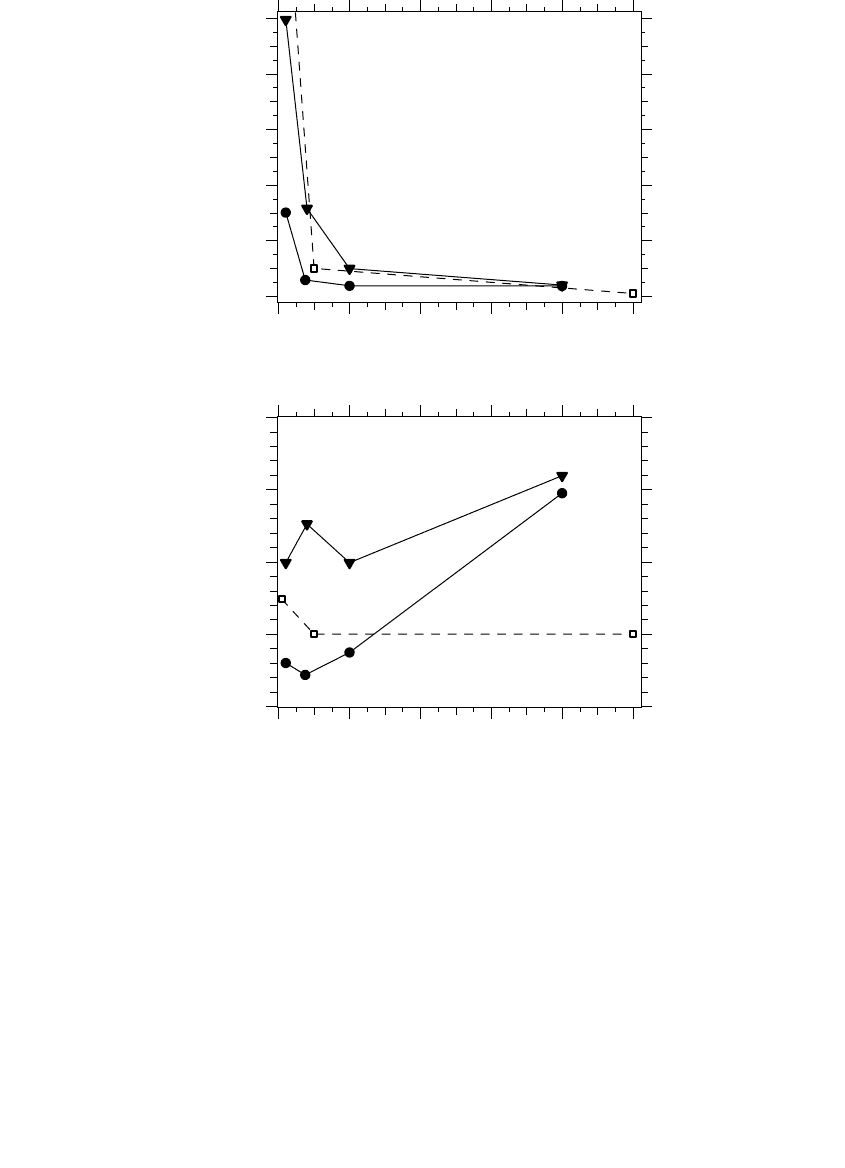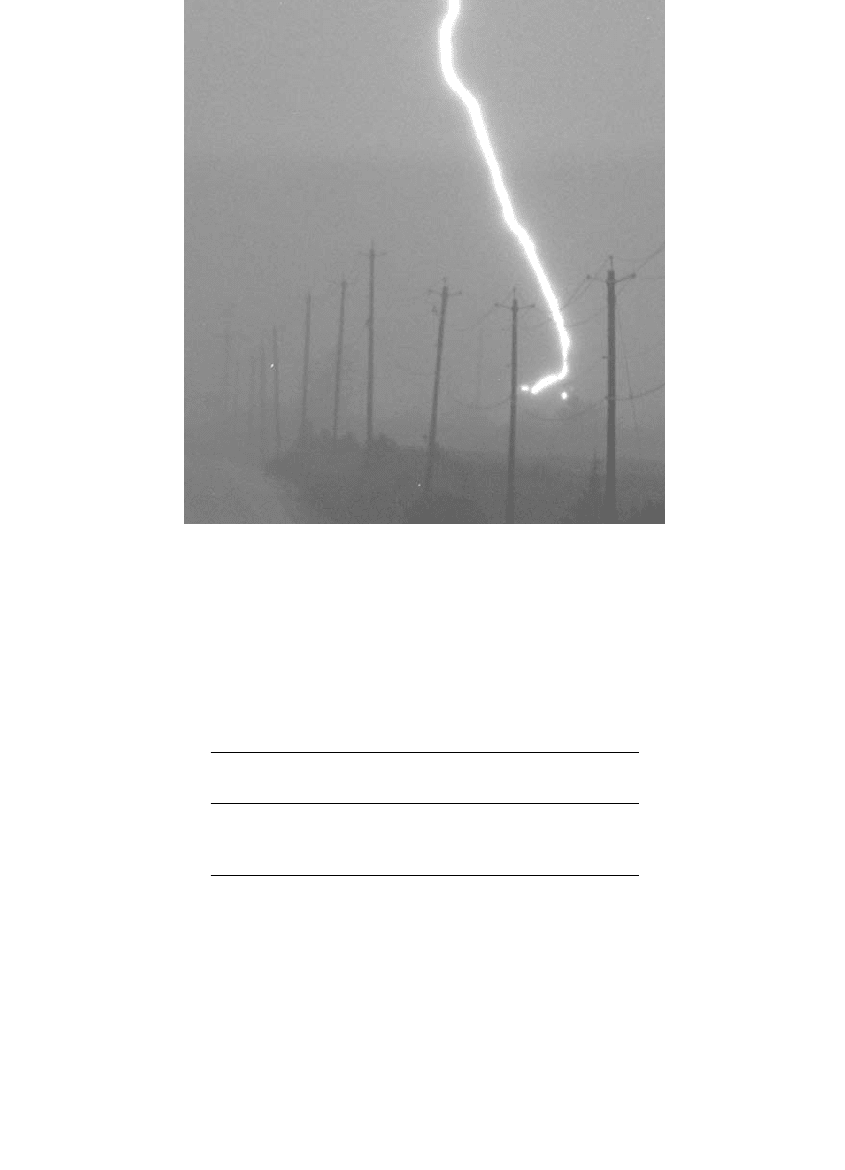Short T.A. Electric Power Distribution Handbook
Подождите немного. Документ загружается.


608 Electric Power Distribution Handbook
12.4.2 Housings
Polymer materials such as silicone or EPR compounds are used for arrester
housings. Porcelain housings are available, and all arresters up until the
1980s were porcelain housed. The main advantage of polymer over the
porcelain is a safer failure mode. An internal fault in a porcelain arrester can
explode the housing and expel porcelain like shrapnel. The polymer housing
will split from the pressures of an internal fault. Arc energies may still crack
apart and eject portions of the blocks; but overall, the failure is less dangerous
than in a porcelain housing. Polymer-housed arresters can pass the ANSI
housing test where a specified fault current is applied for at least 0.1 sec,
and all components of the arrester must remain confined within the enclo-
sure. Polymer-housed arresters typically can pass these criteria for a 5-kA
fault current for 1/2 s (ÚIdt = I◊t = 2500 C). Porcelain-housed arresters fail
violently for these levels of current. Lat and Kortschinski (1981) ruptured
porcelain arresters with fault currents totaling as low as 75 C (6.8 kA for 11
msec, another failed at 2.7 kA for 50 msec). Expulsion fuses may prevent
explosions in porcelain arresters at low short-circuit currents but not at high
currents (current-limiting fuses are needed at high currents).
A polymer housing keeps water out better than a porcelain housing (water
initiates many failure modes). Polymer-housed arresters — although better
than porcelain-housed arresters — are not immune from moisture ingress.
Moisture can enter through leaks in fittings or by diffusing through the
TABLE 12.5
Commonly Applied Arrester Duty-Cycle Ratings
Nominal
System Voltage
(V)
Four-Wire
Multigrounded
Neutral Wye
Three-Wire
Low Impedance
Grounded
Three-Wire High
Impedance
Grounded
2400 3 (2.55)
4160Y/2400 3 (2.55) 6 (5.1) 6 (5.1)
4260 6 (5.1)
4800 6 (5.1)
6900 9 (7.65)
8320Y/4800 6 (5.1) 9 (7.65)
12000Y/6930 9 (7.65) 12 (10.2)
12470Y/7200 9 (7.65) or 10 (8.4) 15 (12.7)
13200Y/7620 10 (8.4) 15 (12.7)
13800Y/7970 10 (8.4) or 12 (10.1) 15 (12.7)
13800 18 (15.3)
20780Y/12000 15 (12.7) 21 (17.0)
22860Y/13200 18 (15.3) 24 (19.5)
23000 30 (24.4)
24940Y/14400 18 (15.3) 27 (22.0)
27600Y/15930 21 (17.0) 30 (24.4)
34500Y/19920 27 (22.0) 36 (29.0)
Note: MCOV ratings are shown in parenthesis.
Source: IEEE Std. C62.22-1997. Copyright 1998 IEEE. All rights reserved.
1791_book.fm Page 608 Monday, August 4, 2003 3:20 PM
(C) 2004 by CRC Press LLC

Lightning Protection 609
polymer material. One utility in a high-lightning area has found polymer-
housed arresters with moisture ingress degradation. These show up on ther-
mal imaging systems where an arrester with moisture ingress may be 50∞C
hotter than adjacent arresters. The utility replaces any arresters with signif-
icant thermovision temperature discrepancies. Lahti et. al. (1998, 1999) per-
formed high humidity tests and hot-water immersion tests on polymer-
housed arresters. Arresters with the housing directly molded onto the
arrester body performed well (no failures). Those with housings pressed on
and fitted with caps at the ends often allowed moisture in through leaks in
the end caps.
12.4.3 Other Technologies
Many older arrester technologies are still in place on distribution circuits.
The most prevalent is the gapped silicon-carbide arrester. Silicon-carbide is
a nonlinear resistive material, but it is not as nonlinear as metal oxide. It
requires a gap to isolate the arrester under normal operating voltage. When
an impulse sparks the gap, the resistance of the silicon-carbide drops, con-
ducting the impulse current to ground. With the gap sparked over, the
arrester continues to conduct 100 to 300 A of power follow current until the
gap clears. If the gap fails to clear, the arrester will fail. Annual failure rates
have been about 1% with moisture ingress into the housing causing most
failures of these arresters [an Ontario-Hydro survey found 86% of failures
were from moisture (Lat and Kortschinski, 1981)]. Moisture degrades the
gap, failing it outright or preventing it from clearing a surge properly. Dar-
veniza et al. (1996) recommended that gapped silicon-carbide arresters older
than 15 years be progressively replaced with metal-oxide arresters. Their
examinations and tests found a significant portion of silicon-carbide arresters
had serious deterioration with a pronounced upturn after about 13 years.
Under-oil arresters are another protection option. Metal-oxide blocks,
mounted inside of transformers, protect the windings with almost no lead
length. Eliminating the external housing eliminates animal faults across
arrester bushings; on padmounted transformers, connector space is freed.
Since the arrester blocks are immersed in the oil, thermal characteristics are
excellent, which improves temporary overvoltage characteristics [Walling
(1994) shows tests where external arresters failed thermally during ferrores-
onance but under-oil arresters survived]. The main disadvantages of under-
oil arresters are related to failures. If the blocks fail, either due to lightning
or other reason, the energy in the long fault arc around or through the arrester
blocks makes transformer tank failures more likely (Henning et al., 1989).
Even if the transformer tank does not fail, since the arrester is a fundamental
component of the transformer, an arrester failure is a transformer failure: a
crew must take the whole transformer back to the shop.
Most metal-oxide arresters are gapless; but a gapped metal-oxide arrester
is available. A portion of the metal-oxide blocks that would normally be
used are replaced with a gap. This improves the protection. When the gap
1791_book.fm Page 609 Monday, August 4, 2003 3:20 PM
(C) 2004 by CRC Press LLC

610 Electric Power Distribution Handbook
sparks over, the surge current creates less voltage because there is less metal
oxide. Once the overvoltage clears, the metal oxide provides considerable
impedance to clear the gap with very little power follow current. The gapped
arrester also has good temporary overvoltage capabilities if the gap does
not spark over. If a lightning stroke or ferroresonance sparks the gap, tem-
porary overvoltages can fail the arrester more quickly. Another disadvantage
is the gap itself, which was the most unreliable part of the gapped silicon-
carbide arrester.
12.4.4 Isolators
Distribution arresters have isolators that remove failed arresters from the
circuit. The isolator has an explosive cartridge that blows the end off of a
failed arrester, which provides an external indication of failure. The isolator
itself is not designed to clear the fault. An upstream protective device nor-
mally must clear the fault (although, in a few cases, the isolator may clear
the fault on its own, depending on the available short-circuit current and
other parameters).
Crews should take care with the end lead that attaches to the bottom of
the arrester. It should not be mounted so the isolator could swing the lead
into an energized conductor if the isolator operates. The proper lead size
should also be used (make sure it is not too stiff, which might prevent the
lead from dropping).
Occasionally, lightning can operate an isolator in cases where the arrester
is still functional. One study found that 53% of arresters removed due to
operation of the isolator were because the isolator operated improperly
(Campos et al., 1997) (this ratio is much higher than normal).
Arrester isolators have a small explosive charge similar to a 0.22 caliber
cartridge. The firing mechanism is a gap in parallel with a resistor. Under
high currents, the gap flashes over. The arc through the gap attaches to the
shell and generates heat that fires the shell. The heat from an arc is roughly
a function of ÚI dt, which is the total charge that passes. Most isolators
operate for a total charge of between 5 and 30 C as shown in Figure 12.14.
A significant portion of lightning flashes contains charge reaching these
amounts. Even though only a portion of the lightning current normally
flows into arresters, a significant number of events will still cause isolator
operation.
Isolators should coordinate with upstream protective devices. Some small
fuses can blow before the isolator clears (the melting time of fuses varies as
ÚI
2
dt, but the isolators vary as ÚI dt, so there is some crossover point). Most
small transformer fuses may clear in less than a half cycle for faults above
1000 A (the clearing time depends on the timing of the fault relative to the
next zero crossing). A 1/2-cycle fault of 1 kA is 8.3 C, which may not fire an
isolator. This is a safety issue since line crews may replace a blown fuse right
next to a failed arrester that was not isolated properly.
1791_book.fm Page 610 Monday, August 4, 2003 3:20 PM
(C) 2004 by CRC Press LLC

Lightning Protection 611
12.4.5 Arrester Reliability and Failures
Modern arresters are reliable components with failure rates much less than
1% annually. They do have somewhat of a bad reputation though, probably
because there were bad products produced by some manufacturers during
the early years of metal-oxide arresters. And their tendency to fail violently
did not help.
One manufacturer states a failure rate less than 0.05% for polymer-
housed arresters. This is primarily based on returned arresters, which are
FIGURE 12.14
Operation time and charge required to operate isolators for different current levels (from three
manufacturers).
0 200 400 600 800 1000
0.0
0.2
0.4
0.6
0.8
1.0
0 200 400 600 800 1000
0
10
20
30
40
Current, A
Operation time, seconds
Current, A
Charge, coulombs
1791_book.fm Page 611 Monday, August 4, 2003 3:20 PM
(C) 2004 by CRC Press LLC

612 Electric Power Distribution Handbook
a low estimate of the true failure rate; arresters are almost a throw-away
commodity; not all failures are returned. Arresters may also fail without
utilities noticing; if the isolator operates and a circuit breaker or recloser
closes back in, the failed arrester is left with a dangling lead that may not
be found for some time. Ontario Hydro (CEA 160 D 597, 1998) has recorded
failure rates averaging about 0.15% in a moderately low-lightning area
with about one flash/km
2
/year. About 40% of their arrester failures
occurred during storm periods.
Lightning arresters fail for a variety of reasons. Moisture ingress, failure
due to lightning, and temporary overvoltages beyond arrester capability
are some of the possibilities. Early in my career, I was involved with lab
tests of arresters and EMTP modeling to evaluate system conditions such
as ferroresonance, presence of distributed generation, and regulation volt-
ages (Short et al., 1994). The main conclusion was that well-made arresters
should perform well. More problems were likely for tightly applied arrest-
ers (such as using a 9-kV duty-cycle arrester with a 7.65-kV MCOV on a
12.47/7.2-kV system), so avoid tightly applying arresters under normal
circumstances.
Darveniza et al. (2000) inspected several arresters damaged in service in
Australia. Of the gapped metal-oxide arresters inspected, both polymer and
porcelain-housed units, moisture ingress caused most failures. Of the gapless
metal-oxide arresters inspected, several were damaged under conditions that
were likely ferroresonance — arresters on riser poles with single-pole switch-
ing or with a cable fault. Another portion were likely from severe lightning,
most likely from multiple strokes. Most of the failures occurred along the
outer surface of the blocks. A small number of metal-oxide arresters, both
polymer and porcelain, showed signs of moisture ingress damage, but over-
all, the metal-oxide arresters had fewer problems with moisture ingress than
might be expected.
Lightning causes some arrester failures. Figure 12.15 shows an example.
The standard test waves (4/10 msec or 8/20 msec) do not replicate lightning
very well but are assumed to test an arrester well enough to verify field
performance. The energy of standard test waves along with the charge is
shown in Table 12.6. Charge corresponds well with arrester energy input
since the arrester discharge voltage stays fairly constant with current.
Studies of surge currents through arresters show that individual arresters
only conduct a portion of the lightning current. Normally, the lightning
current takes more than one path to ground. Often that path is a flashover
caused by the lightning; the flashover is a low-impedance path that “pro-
tects” the arrester. The largest stroke through an arrester measured during
an EPRI study with more than 200 arrester years of monitoring using light-
ning transient recorders measured 28 kA (Barker et al., 1993). During the
study, 2% of arresters discharged more than 20 kA annually. The largest
energy event was 10.2 kJ/kV of MCOV rating (the arrester did not fail, but
larger than normal 4.7-cm diameter blocks were used).
1791_book.fm Page 612 Monday, August 4, 2003 3:20 PM
(C) 2004 by CRC Press LLC

Lightning Protection 613
Manufacturers often cite 2.2 kJ/kV of MCOV rating as the energy capa-
bility of heavy-duty arresters. The actual capability is probably higher than
this. If test results from station-class arresters (Ringler et al., 1997) are trans-
lated to equivalent distribution size blocks, heavy-duty arresters should
withstand 6 to 15 kJ/kV of MCOV (the 100-kA test produces about 4 to 7
kJ/kV of MCOV). Metal-oxide blocks exhibit high variability in energy capa-
bility, even in the same manufacturing batch.
FIGURE 12.15
Lightning flash that failed an arrester. The circuit in the foreground curves around to the right
about a mile beyond the visible poles. Flashovers occurred at poles on either side of the strike
point. An arrester failed on one of the poles. (Copyright 1991, Niagara Mohawk Power Corpo-
ration. Reprinted with permission.)
TABLE 12.6
Approximate Energy and Charge in ANSI/IEEE
Arrester Test Current Waves
(ANSI/IEEE C62.11-1987)
Test Wave
Energy,
kJ/kV of MCOV Charge, C
100 kA, 4/10 msec 4.5 1.0
40 kA, 8/20 msec 3.6 0.8
10 kA, 8/20 msec 0.9 0.2
1791_book.fm Page 613 Monday, August 4, 2003 3:20 PM
(C) 2004 by CRC Press LLC

614 Electric Power Distribution Handbook
Darveniza et al. (1994, 1997) found that multiple strokes are more damag-
ing to arresters. Less energy is needed to fail the arrester. The failures occur
as flashovers along the surface of the metal-oxide blocks. The block surface
coating plays an important role; contamination and moisture increased the
probability of failure. Five 8/20-msec test waves were applied within an
interval of 40 msec between each. A set of five 10-kA impulses applies about
4 kJ/kV of MCOV. Many of the arrester designs failed these tests. The best
design had a housing directly molded onto the blocks.
Longer-duration surges also fail arresters at lower energy levels. Tests by
Kannus et al. (1999) on polymer-housed arresters found many failures with
2.5/70-msec test waves with a peak value of about 2 kA. As with multiple
impulse tests, the outside of the blocks flashed over. Some arresters failed
with as little as 0.5 kJ/kV of MCOV. Moisture ingress increased the failure
probability for some arrester designs (Lahti et al., 2001).
This brings us to a common but difficult to answer question, should we
use normal-duty or heavy-duty arresters? Heavy-duty arresters have more
energy capability. This reduces the chance of failure due to severe lightning
or temporary overvoltages such as ferroresonance. They also have lower
discharge voltages (although the extra margin is not usually needed for
protecting overhead equipment). Normal duty arresters cost less, so the
question remains as to whether the extra capability of the larger arrester is
worth it. For most locations, heavy-duty arresters are appropriate, except in
low lightning areas with less than 0.5 flashes/km
2
/year. However, this
depends on the environmental exposure (how many trees are around), utility
stocking and standardization considerations (for example, are transformer
arresters the same as arresters at riser poles?), and cost considerations.
12.5 Equipment Protection
Insulation coordination of distribution systems involves some simple steps:
1. Choose the arrester rating based on the nominal system voltage and
the grounding configuration.
2. Find the discharge voltage characteristics of the arrester.
3. Find the voltage that may be impressed on the insulation, consider-
ing any lead length and for cables, any traveling wave effects.
4. Finally, ensure that the impressed voltage is less than the equipment
insulation capability, including a safety margin.
As with many aspects of distribution engineering, standards help simplify
applications. Normally, utilities can standardize equipment protection for a
particular voltage including arrester rating, class, and location, and excep-
1791_book.fm Page 614 Monday, August 4, 2003 3:20 PM
(C) 2004 by CRC Press LLC

Lightning Protection 615
tions are rarely needed. Construction framing drawings specify how to apply
arresters to minimize lead length.
12.5.1 Equipment Insulation
Distribution insulation performance is characterized with the Basic Lightning
Impulse Insulation Level (BIL). BIL is the peak withstand voltage for a 1.2/50-
msec impulse wave. IEEE Std. 4-1995 defines voltage impulse test waves as
t
1
/t
2
msec where t
1
is the equivalent time to crest based on the time taken to
rise from 30 to 90% of the crest (see Figure 12.16). The time to half value t
2
is the time between the origin of the 30 to 90% virtual front and the point
where it drops to half value. Equipment must withstand a certain number
of applications of the test wave under specified conditions.
Standard BIL ratings for distribution equipment are 30, 45, 60, 75, 95, 125,
150, 200, 250, and 350 kV. Most equipment has the BILs given in Table 12.7.
Some insulation is also tested with a chopped wave. A chopped wave has
the same characteristic as the 1.2/50-msec wave, but the waveshape is
chopped off after 2 or 3 msec. Because the voltage stress does not last as long,
with most equipment, the chopped wave withstand (CWW) is higher than
the BIL. The CWW values given in Table 12.7 are for transformers (IEEE
FIGURE 12.16
Standard impulse voltage test wave. (From IEEE Std. 4-1995. Copyright 1995 IEEE. All rights
reserved.)
TABLE 12.7
Distribution Equipment Insulation
Impulse Levels (BIL and CWW)
Voltage Class, kV BIL, kV CWW, kV
a
56069
15 95 110
25 125 145
35 150 175
a
For transformers: other equipment may
have different CWW.
1.0
0.9
0.5
0.3
t
1
t
2
1791_book.fm Page 615 Monday, August 4, 2003 3:20 PM
(C) 2004 by CRC Press LLC

616 Electric Power Distribution Handbook
C57.12.00-2000). For transformers and other oil-filled equipment and insu-
lators and other air mediums, assume CWW = 1.15 · BIL. For cable insulation,
assume they are equal; CWW = BIL.
Insulation withstands higher voltages when the voltage is applied for
shorter periods. The volt-time or time-lag characteristic of insulation shows
this effect with the time to failure of a given crest magnitude. The volt-time
characteristic of air insulation turns up significantly; oil-filled insulation
turns up less, and solid insulation, very little. For solid insulations like EPR
and XLPE, the small turnup is why the chopped wave withstand is the same
as the BIL.
12.5.2 Protective Margin
Insulation coordination for distribution systems involves checking to see if
there is enough margin between the voltage across the insulation and the
insulation’s capability. A protective margin quantifies the margin between
the voltage the surge arrester allows (protective level) and the insulation
withstand. For overhead transformers and other overhead equipment, we
evaluate two protective margins both in percent, one for the chopped wave
and one for the full wave (IEEE Std. C62.22-1997):
where
CWW = Chopped wave withstand, kV
FOW = Front-of-wave protective level, kV
BIL = Basic lightning impulse insulation level, kV
LPL = Lightning impulse protective level, kV
Ldi/dt = the lead wire voltage due to the rate of change of the current, kV
Both margins should be over 20% (IEEE Std. C62.22-1997); and for various
reasons, we are safer having at least 50% margin. The chopped-wave pro-
tective margin includes voltage due to the rate of change of current through
the arrester leads.
Protective margins for common voltages are shown in Table 12.8 and Table
12.9. The BIL margin is high in all cases; but with long lead lengths, the
CWW margin is low enough to pose increased risk of failure.
The lead length component is very important; the lead voltage can con-
tribute as much as the arrester protective level for long lengths. The arrester
lead inductance is approximately 0.4 mH/ft (1.3 mH/m). Commonly, a rate
of current change is assumed to be 20 kA/msec. Together, this is 8 kV/ft of
PM
Ldi dt
PM
CWW
BIL
=
CWW
FOW
=
BIL
LPL
+
-
È
Î
Í
˘
˚
˙
◊
-
È
Î
Í
˘
˚
˙
◊
/
1 100
1 100
1791_book.fm Page 616 Monday, August 4, 2003 3:20 PM
(C) 2004 by CRC Press LLC

Lightning Protection 617
lead length (26 kV/m). This is not an unreasonable rate of rise to use in the
calculation; 20 kA/msec is about the median value for subsequent strokes
during the rise from 30 to 90%.
Lead lengths less than 3 ft (1 m) are necessary to achieve a 50% margin
for protecting overhead equipment. The easiest approach is to tank mount
arresters. Pole or crossarm mounting makes it harder to keep reasonable
lead lengths. It is important to remember that lead length includes the
ground lead as well as the phase wire lead, and the lead-length path is along
the path that the lightning current flows from the phase wire to ground (see
Figure 12.17). Some important, but obvious directions for arrester applica-
tion are:
1. Do not coil leads — While this may look tidy, the inductance is very
high.
TABLE 12.8
Typical BIL Protective Margins for Common
Distribution Voltages (Using the 10-kA Lightning
Protective Level)
System Voltage
(kV)
Arrester MCOV
(kV)
BIL
(kV)
LPL
(kV) PM
BIL
12.47Y/7.2 8.4 95 32 197%
24.9Y/14.4 15.3 125 58 116%
34.5Y/19.9 22 150 87 72%
TABLE 12.9
Typical CWW Protective Margins for Common Distribution Voltages
(Assuming 8 kV/ft, 26 kV/m of Lead Length)
System Voltage
(kV)
Arrester MCOV
(kV)
CWW
(kV)
FOW
(kV)
Ldi/dt
(kV) PM
CWW
No Lead Length
12.47Y/7.2 8.4 110 36 0 206%
24.9Y/14.4 15.3 145 65 0 123%
34.5Y/19.9 22 175 98 0 79%
3-ft (0.9-m) Lead Length
12.47Y/7.2 8.4 110 36 24 83%
24.9Y/14.4 15.3 145 65 24 63%
34.5Y/19.9 22 175 98 24 43%
6-ft (1.8-m) Lead Length
12.47Y/7.2 8.4 110 36 48 31%
24.9Y/14.4 15.3 145 65 48 28%
34.5Y/19.9 22 175 98 48 20%
1791_book.fm Page 617 Monday, August 4, 2003 3:20 PM
(C) 2004 by CRC Press LLC
